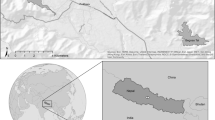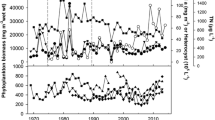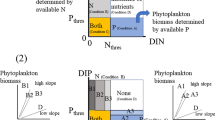Abstract
We examine macronutrient limitation in New Zealand (NZ) lakes where, contrary to the phosphorus (P) only control paradigm, nitrogen (N) control is widely adopted to alleviate eutrophication. A review of published results of nutrient enrichment experiments showed that N more frequently limited lake productivity than P; however, stoichiometric analysis of a sample of 121 NZ lakes indicates that the majority (52.9%) of lakes have a mean ratio of total nitrogen (TN) to total phosphorus (TP) (by mass) indicative of potential P-limitation (>15:1), whereas only 14.0% of lakes have mean TN:TP indicative of potential N-limitation (<7:1). Comparison of TN, TP, and chlorophyll a data between 121 NZ lakes and 689 lakes in 15 European Union (EU) countries suggests that at the national scale, N has a greater role in determining lake productivity in NZ than in the EU. TN:TP is significantly lower in NZ lakes across all trophic states, a difference that is driven primarily by significantly lower in-lake TN concentrations at low trophic states and significantly higher TP concentrations at higher trophic states. The form of the TN:TP relationship differs between NZ and the EU countries, suggesting that lake nutrient sources and/or loss mechanisms differ between the two regions. Dual control of N and P should be the status quo for lacustrine eutrophication control in New Zealand and more effort is needed to reduce P inputs.



Similar content being viewed by others
References
APHA. 1998. Standard methods for the examination of water and wastewater. 20th edn. Washington, DC: American Public Health Association.
Barica J. 1990. Seasonal variability of N:P ratios in eutrophic lakes. Hydrobiologia 191:97–103.
Bayer TK, Schallenberg M, Martin CE. 2008. Investigation of nutrient limitation status and nutrient pathways in Lake Hayes, Otago, New Zealand: a case study for integrated lake assessment. N Z J Mar Freshw Res 42:285–95.
Burger DF, Hamilton DP, Hall JA, Ryan EF. 2007. Phytoplankton nutrient limitation in a polymictic eutrophic lake: community versus species-specific responses. Fundam Appl Limnol 169:57–68.
Burns N, Rutherford JC, Clayton JS. 1999. A monitoring and classification system for New Zealand lakes and reservoirs. J Lakes Res Manag 15:225–71.
Burns N, Bryers G, Bowman E. 2000. Protocol for monitoring lake trophic levels and assessing trends in trophic state. Wellington: Ministry for the Environment. p 130.
Burns N, McIntosh J, Scholes P. 2009. Managing the lakes of the Rotorua district, New Zealand. Lake Reserv Manag 25:284–96.
Carpenter SR, Caraco NF, Correll DL, Howarth RW, Sharpley AN, Smith VH. 1998. Nonpoint pollution of surface waters with phosphorus and nitrogen. Ecol Appl 8:559–68.
Carlson RE. 1977. A trophic state index for lakes. Limnol Oceanogr 22:361–9.
Chang FH, Uddstrom MJ, Pinkerton MH, Richardson KA. 2008. Characterising the 2002 toxic Karenia concordia (Dinophyceae) outbreak and its development using satellite imagery on the north-eastern coast of New Zealand. Harmful Algae 7:532–44.
Cherry KA, Shepherd M, Withers PJA, Mooney SJ. 2008. Assessing the effectiveness of actions to mitigate nutrient loss from agriculture: a review of methods. Sci Total Environ 406:1–23.
Conley DJ, Paerl HW, Howarth RW, Boesch DF, Seitzinger SP, Havens KE, Lancelot C, Likens GE. 2009. Controlling eutrophication: nitrogen and phosphorus. Science 323:1014–15.
Downing JA, McCauley E. 1992. The nitrogen–phosphorus relationship in lakes. Limnol Oceanogr 37:936–45.
Downs TM, Schallenberg M, Burns CW. 2008. Responses of lake phytoplankton to micronutrient enrichment: a study in two New Zealand lakes and an analysis of published data. Aquat Sci 70:347–60.
Droop MR. 1977. An approach to quantitative nutrition of the phytoplankton. J Eukaryot Microbiol 24:528–32.
Edgar N. 2009. Icon lakes in New Zealand: managing the tension between land development and water resource protection. Soc Nat Resour 22:1–11.
Elser JJ, Andersen T, Baron JS, Bergstrom A-K, Jansson M, Kyle M, Nydick KR, Steger L, Hessen DO. 2009a. Shifts in lake N:P stoichiometry and nutrient limitation driven by atmospheric nitrogen deposition. Science 326:835–7.
Elser JJ, Bracken MES, Cleland EE, Gruner DS, Harpole WS, Hillebrand H, Ngai JT, Seabloom EW, Shurin JB, Smith JE. 2007. Global analysis of nitrogen and phosphorus limitation of primary producers in freshwater, marine and terrestrial ecosystems. Ecol Lett 10:1135–42.
Elser JJ, Kyle M, Steger L, Nydick KR, Baron JS. 2009b. Nutrient availability and phytoplankton nutrient limitation across a gradient of atmospheric nitrogen deposition. Ecology 90:3062–73.
Environment Waikato. 2003. Protecting Lake Taupo: a long term strategic partnership. Hamilton East: Environment Waikato. p 28.
European Environment Agency. 2009a. Waterbase-Lakes Quality database. www.eea.europa.eu/data-and-maps/data/waterbase-lakes-5. Accessed 01.02.2010.
European Environment Agency. 2009b. Waterbase-Lakes Version 9: Quality control documentation. www.eea.europa.eu/data-and-maps/data/waterbase-lakes-5. Accessed 01.02.2010.
Fleming RH. 1940. The composition of plankton and units for reporting populations and production. Proc Sixth Pac Sci Congr 3:535–40.
Guildford SJ, Hecky RE. 2000. Total nitrogen, total phosphorus, and nutrient limitation in lakes and oceans: is there a common relationship? Limnol Oceanogr 45:1213–23.
Guildford SJ, Hecky RE, Taylor WD, Mugidde R, Bootsma HA. 2003. Nutrient enrichment experiments in tropical Great Lakes Malawi/Nyasa and Victoria. J Great Lakes Res 29:89–106.
Håkanson L, Bryhn AC, Hytteborn JK. 2007. On the issue of limiting nutrient and predictions of cyanobacteria in aquatic systems. Sci Total Environ 379:89–108.
Hamilton DH. 2005. Land use impacts on nutrient export in the Central Volcanic Plateau, North Island. New Zealand. J For 49:27–31.
Healey FP, Hendzel LL. 1979. Indicators of phosphorus and nitrogen deficiency in five algae in culture. J Fish Res Board Can 36:1364–9.
Hecky RE, Kilham P. 1988. Nutrient limitation of phytoplankton in freshwater and marine environments: a review of recent evidence on the effects of enrichment. Limnol Oceanogr 33:796–822.
Heggie K, Savage C. 2009. Nitrogen yields from New Zealand coastal catchments to receiving estuaries. N Z J Mar Freshw Res 43:1039–52.
Hessen DO, Andersen T, Larsen S, Skjelkvale BL, de Wit HA. 2009. Nitrogen deposition, catchment productivity, and climate as determinants of Lake Stoichiometry. Limnol Oceanogr 54:2520–8.
Holland EA, Braswell BH, Sulzman J, Lamarque JF. 2005. Nitrogen deposition onto the United States and western Europe: synthesis of observations and models. Ecol Appl 15:38–57.
Howarth RW, Marino R, Lane J, Cole JJ. 1988. Nitrogen fixation in freshwater, estuarine, and marine ecosystems. 1. Rates and importance. Limnol Oceanogr 33:669–87.
Lean DRS, Mitchell SF, Pick FR, Rueter JG, Downes MT, Payne GW, Pickmere SE, White E, Woods PH. 1987. The effects of changes in the abundance of nitrogen and phosphorus and their ratio on Lake Okaro phytoplankton, with comment on six other central volcanic plateau lakes. N Z J Mar Freshw Res 21:539–42.
Lewis WM, Wurtsbaugh WA. 2008. Control of lacustrine phytoplankton by nutrients: erosion of the phosphorus paradigm. Int Rev Hydrobiol 93:446–65.
McDowell RW, Larned ST, Houlbrooke DJ. 2009. Nitrogen and phosphorus in New Zealand streams and rivers: control and impact of eutrophication and the influence of land management. N Z J Mar Freshw Res 43:985–95.
Ministry for the Environment. 2007. Lake water quality in New Zealand: status in 2006 and recent trends 1990–2006, vol 74. Wellington, New Zealand. Publication number: ME 832.
Mitchell SF, Burns CW. 1981. Phytoplankton photosynthesis and its relation to standing crop and nutrients in two warm-monomictic South Island lakes. N Z J Mar Freshw Res 15:51–67.
Morris DP, Lewis WM. 1988. Phytoplankton nutrient limitation in Colorado mountain lakes. Freshw Biol 20:315–27.
Moss B, Stephen D, Balayla DM, Becares E, Collings SE, Fernandez-Alaez C, Fernandez-Alaez M, Ferriol C, Garcia P, Goma J, Gyllstrom M, Hansson LA, Hietala J, Kairesalo T, Miracle MR, Romo S, Rueda J, Russell V, Stahl-Delbanco A, Svensson M, Vakkilainen K, Valentin M, Van de Bund WJ, Van Donk E, Vicente E, Villena MJ. 2004. Continental-scale patterns of nutrient and fish effects on shallow lakes: synthesis of a pan-European mesocosm experiment. Freshw Biol 49:1633–49.
OECD. 1982. Eutrophication of waters—monitoring, assessment and control. Paris: Organisation for Economic Co-operation and Development. 154 pp.
Özkundakci D, Hamilton DH, Scholes P. 2010. Effect of intensive catchment and in-lake restoration procedures on phosphorus concentrations in a eutrophic lake. Ecol Eng 36:396–405.
Paerl HW. 2009. Controlling eutrophication along the freshwater-marine continuum: dual nutrient (N and P) reductions are essential. Estuaries Coasts 32:593–601.
Parfitt RL, Baisden WT, Elliott AH. 2008. Phosphorus inputs and outputs for New Zealand in 2001 at national and regional scales. J Roy Soc N Z 38:37–50.
Parfitt RL, Schipper LA, Baisden WT, Elliott AH. 2006. Nitrogen inputs and outputs for New Zealand in 2001 at national and regional scales. Biogeochemistry 80:71–88.
Redfield AC, Ketchum BH, Richards FA. 1963. The influence of organisms on the composition of seawater. In: Hill MN, Ed. The composition of sea-water comparative and descriptive oceanography. New York: Wiley Interscience. p 26–72.
Schindler DW. 1974. Eutrophication and recovery in experimental lakes: implications for lake management. Science 184:897–9.
Schindler DW. 1977. Evolution of phosphorus limitation in lakes. Science 195:260–2.
Schindler DW. 1998. Replication versus realism: the need for ecosystem-scale experiments. Ecosystems 1:323–34.
Schindler DW, Hecky RE. 2009. Eutrophication: more nitrogen data needed. Science 324:721–2.
Schindler DW, Hecky RE, Findlay DL, Stainton MP, Parker BR, Paterson MJ, Beaty KG, Lyng M, Kasian SEM. 2008. Eutrophication of lakes cannot be controlled by reducing nitrogen input: results of a 37-year whole-ecosystem experiment. Proc Natl Acad Sci 105:11254–8.
Scott JT, McCarthy MJ. 2010. Nitrogen fixation may not balance the nitrogen pool in lakes over timescales relevant to eutrophication management. Limnol Oceanogr 55:1265–70.
Seitzinger S, Harrison JA, Bohlke JK, Bouwman AF, Lowrance R, Peterson B, Tobias C, Van Drecht G. 2006. Denitrification across landscapes and waterscapes: a synthesis. Ecol Appl 16:2064–90.
Smith VH. 1982. The nitrogen and phosphorus dependence of algal biomass in lakes: an empirical and theoretical analysis. Limnol Oceanogr 27:1101–12.
Smith VH, Bierman VJ, Jones BL, Havens KE. 1995. Historical trends in the Lake Okeechobee ecosystem IV. Nitrogen:phosphorus ratios, cyanobacterial dominance and nitrogen fixation potential. Arch Hydrobiol Monogr Beitr 107:71–88.
Smith VH, Schindler DW. 2009. Eutrophication science: where do we go from here? Trends Ecol Evol 24:201–7.
Smith VH, Tilman GD, Nekola JC. 1999. Eutrophication: impacts of excess nutrient inputs on freshwater, marine, and terrestrial ecosystems. Environ Pollut 100:179–96.
Statistics New Zealand. 2008. Agricultural production census. Obtained from the INFOS database. www.maf.govt.nz. Accessed 01.03.2010.
Sterner RW. 2008. On the phosphorus limitation paradigm for lakes. Int Rev Hydrobiol 93:433–45.
Sterner RW, Hessen DO. 1994. Algal nutrient limitation and the nutrition of aquatic herbivores. Annu Rev Ecol Syst 25:1–29.
Timperley MH. 1983. Phosphorus in spring waters of the Taupo Volcanic Zone, North Island, New Zealand. Chem Geol 38:287–306.
van der Ploeg RR, Bohm W, Kirkham MB. 1999. On the origin of the theory of mineral nutrition of plants and the law of the minimum. Soil Sci Soc Am J 63:1055–62.
Wang HJ, Wang HZ. 2009. Mitigation of lake eutrophication: loosen nitrogen control and focus on phosphorus abatement. Prog Nat Sci 19:1445–51.
Welch EB. 2009. Should nitrogen be reduced to manage eutrophication if it is growth limiting? Evidence from Moses Lake. Lake Reserv Manag 25:401–9.
White E. 1983. Lake eutrophication in New Zealand - a comparison with other countries of the Organisation for Economic Co-operation and Development. N Z J Mar Freshw Res 17:437–44.
White E, Law K, Payne G, Pickmere S. 1985. Nutrient demand and availability among planktonic communities - an attempt to assess nutrient limitation to plant growth in 12 central volcanic plateau lakes. N Z J Mar Freshw Res 19:49–62.
White E, Payne G, Pickmere S, Woods P. 1991. Seasonal-variation in nutrient limitation of the algal community in Lake Horowhenua, New Zealand. N Z J Mar Freshw Res 25:311–16.
White E, Payne GW. 1977. Chlorophyll production, in response to nutrient additions, of the algae in Lake Taupo water. N Z J Mar Freshw Res 11:501–7.
White E, Payne GW. 1978. Chlorophyll production, in response to nutrient additions, by the algae in Lake Rotorua water. N Z J Mar Freshw Res 12:131–8.
Wilcock RJ, Betteridge K, Shearman D, Fowles CR, Scarsbrook MR, Thorrold BS, Costall D. 2009. Riparian protection and on-farm best management practices for restoration of a lowland stream in an intensive dairy farming catchment: a case study. N Z J Mar Freshw Res 43:803–18.
Acknowledgements
We acknowledge the New Zealand Regional Councils and Ministry for the Environment for permission to use data for New Zealand lakes and the European Environment Agency for providing European lake data. We thank William Lewis, Stephen Carpenter, Erik Jeppesen and one anonymous reviewer for comments that improved the manuscript, and Ray Littler for statistical advice. The first author is a PhD student funded by a Commonwealth Scholarship and an Environment Bay of Plenty study award. This study was also supported through the Lake Biodiversity Restoration program funded by the New Zealand Foundation of Research, Science and Technology (UOWX0505).
Author information
Authors and Affiliations
Corresponding author
Additional information
Author Contributions
JA, DO, and DH conceived the study, JA and DO performed the research and analyzed the data, JA wrote the paper with substantial editorial input from DO and DH.
Rights and permissions
About this article
Cite this article
Abell, J.M., Özkundakci, D. & Hamilton, D.P. Nitrogen and Phosphorus Limitation of Phytoplankton Growth in New Zealand Lakes: Implications for Eutrophication Control. Ecosystems 13, 966–977 (2010). https://doi.org/10.1007/s10021-010-9367-9
Received:
Accepted:
Published:
Issue Date:
DOI: https://doi.org/10.1007/s10021-010-9367-9




